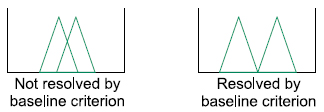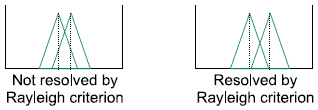Optipedia • SPIE Press books opened for your reference.
Resolution
Excerpt from Field Guide to Spectroscopy
Resolution is a measure of how close two different spectral signals can be but still be differentiated as separate signals. For dispersive spectrometers, resolution is largely a function of slit width, W, and the reciprocal linear dispersion, Rd, of the monochromator. The resolving power R of a spectrometer is defined as

where λ is the average wavelength between the two signals and Δλ is the difference between them.
Experimentally, there are two common criteria used to decide if two nearby signals are resolved or not. The baseline criterion requires that the plot of the spectrum return to baseline at some point between the two signals.

The Rayleigh criterion requires that the maximum of one signal must be at a wavelength that corresponds to a minimum of the other. Deconvolution of the spectrum may be necessary to determine if two signals are considered resolved according to this criterion.

D. W. Ball, Field Guide to Spectroscopy, SPIE Press, Bellingham, WA (2006).
View SPIE terms of use.

